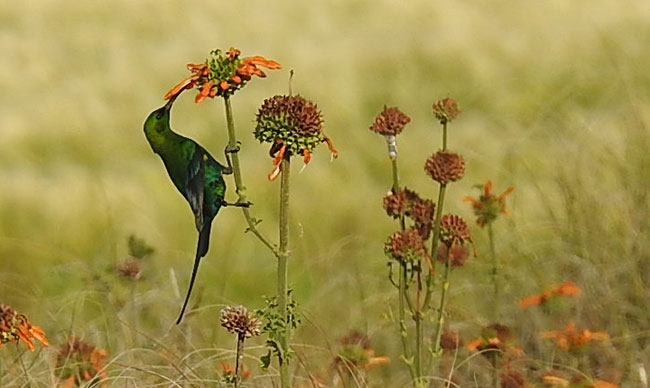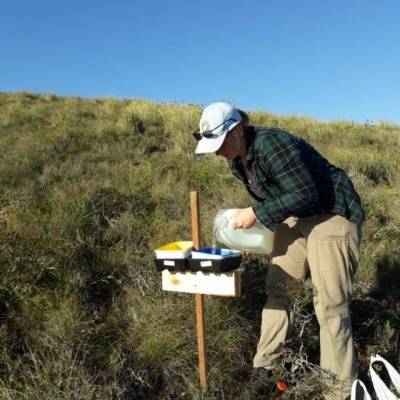By Tabitha Coetzee
Pollinators made global headlines last year, when studies around the world showed that 40% of pollinators face extinction over the coming decades.
Above: Ants and beetles visiting a Berkheya armata flower
Even in Renosterveld, without insect, mammal and bird pollinators, Renosterveld would be in serious trouble.
In an attempt to better understand pollinator networks, the presence and absence of pollinators and pollination success rates, a number of postgraduate students are focusing on pollination in the Overberg Renosterveld. This research is co-supervised by Prof Sjirk Geerts at CPUT (Cape Peninsula University of Technology), Dr Tineke Kraaij at NMU (Nelson Mandela University) and Director of the ORCT, Dr Odette Curtis-Scott.
Above: Malachite sunbird visiting Wild Dagga (Leonitis leonorus), the only bird-flower interactions observed
In my own research, my focus to date has been on creating pollination networks, and analysing how their occurrence may differ between agricultural landscapes and natural landscapes of Eastern Rûens Shale Renosterveld.
And in the past year of my research (2019), I experienced many challenges, but also many victories. Here’s a brief update on the work to date:
- The data collection has been quite successful. But the drought did affect the data collection as spring ended earlier than expected and flowers did not last as long as we hoped. However we made the best of the period we had, with 2,453 total interactions recorded over 138 hours of observation on 95 floral species across 9 sites on Haarwegskloof and neighbouring farms with Renosterveld patches. So far it is clear that fragments that are highly or partially isolated are just as significant, if not more significant in terms of species composition and number of interactions, than fully connected “mainland” sites. It shows the importance of protecting these isolated fragments. Highly isolated areas seem to have the highest number of interactions (918 total of 3 sites), number of flowering species (58) and total number of visitors/pollinators (325 so far, pending final identification) when compared to semi-connected / low-isolated areas and mainland sites.
- Our coloured water pan traps (sets of yellow, blue, white and red traps filled with soapy water set up in agricultural and natural land and connecting corridors) were a huge success, with 144 jars containing thousands of insects/arthropods collected in the area surrounding Haarwegskloof and neighbouring farms.
- From the Overberg, my journey then took me to the Grootbos Foundation, where I learnt the basics of pinning and identifying insects and had some help in doing so.
But there’s much work that lies ahead – and this is likely to provide more answers to those burning questions that remain.
For example, we plan on collecting some data on bird and rodent pollination using camera traps over spring this year. So far most of the data has been on invertebrates, and we will try and investigate the gaps, where certain flowering species had no interactions, wherever possible. However, if time and other constraints prevent us from completing this then it will be open for investigation in future research.
We will also continue to identify the remaining insect species that we collected, in order to create pollination networks and analyse how they differ across connected areas and fragments. Secondly the arthropods (insects with an exoskeleton, segmented body and paired joint appendages) caught on the traps will be identified to establish the species assemblages in the different land uses. This will allow us to analyse how pollinators may use our Renosterveld habitat and agricultural lands differently.
I’m so grateful to the Fynbos Trust for their support towards my research, to all the volunteers and assistants who have helped me, and to Odette and the ORCT team for their undying support. Without the ORCT, the project would never have taken off and I’m especially grateful for the opportunity to work on Haarwegskloof, and for the connections with the wonderful farmers I had the opportunity to meet and work with.



















